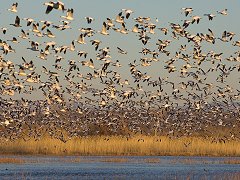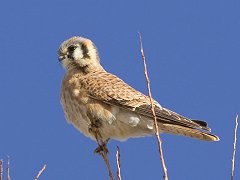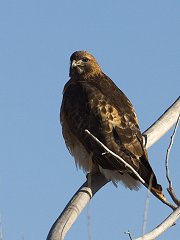|
Bosque del Apache NWR January 14-17, 2007
When I was growing up on the South Dakota tundra I figured that folks in balmy New Mexico didn't even bother to put furnaces in their houses. I found that memory quite amusing at dawn on Jan. 16 as my extremities got more and more cold and numb. I was at Bosque del Apache National Wildlife Refuge in central New Mexico waiting with my camera for the snow geese to blast off for the day and head to their feeding grounds. The fellow idiots, er, photographers who were also waiting commented as the sun roser higher in the sky that the geese had taken off just after sunrise the previous day. Just my luck that the geese chose that day to sleep in. By the time they eventually took off half an hour after sunrise, it had clouded over a bit and the photographic result wasn't too great. Actually the image at right from the previous evening was much better. (And it was warmer, and it was a more reasonable hour of the day.) When I'm asked why I go to this place, I always cite the sandhill cranes, the snow geese and ducks. Actually that's a bit of a lie. If there were no raptors around, I probably wouldn't bother. There were three eagles (two adults and a juvenile), so if you just want to see eagles there are better places to go. But on this trip, I saw the most harrier hawks I've ever seen, and I also got the best views I've ever gotten of little kestrels. The harriers are difficult to photograph because they range widely and the best I got was some fairly distant shots. But the kestrels were quite cooperative a couple of times.
It was interesting the way the snow geese responded to the various raptors. The flock of geese feeding in a corn field didn't budge when a harrier glided past. But when the juvenile bald eagle came toward the geese, they bolted into the air. I don't think an eagle will try to take a healthy goose, but I got the impression that the eagles stirred up the geese once in a while to see if there were any disabled ones lagging behind. At a different location, I saw one of the adults hauling the remains of a coot up into a tree. In addition to the eagles, harriers and kestrels, I also saw several hawks. One of the hawks was very dark brown, so I feared that my default ID of "Red-tailed Hawk" might not apply in this instance. However, it didn't seem to match any of the other hawks that are listed as common to Bosque, and my Sibley book says there is a wide variation in the coloration of red tails in the West. So it's a red tail unless someone can tell me otherwise.
The other thing I noticed on this trip was the abudance of roadrunners. I recall I had seen a roadrunner only once on the three previous trips, but this time I saw five or six at different locations. I wondered if it was a coincidence that I didn't see any coyotes. My working theory is that the seasonal flooding of the fields discourages the coyotes from coming around, and the roadrunners are less shy than at other times of the year. But on other trips I saw lots of pheasants and only saw (or almost stepped on) just one this time. If you do a web search on "Bosque del Apache" you'll find plenty of great photos, and you may notice that a lot of them are more colorful than mine. Back in the days of film, photographers who wanted vivid, almost unnatural color saturation used Fuji Velvia slide film. In the days of digital, they pump up the color saturation in Photoshop. That always bothered me a bit, perhaps because my training is as a journalist, not an artist. But I probably add a bit more saturation now than five years ago. In another few years, perhaps I'll be brave enough to move the saturation slider a bit more, then when it looks garish enough I can call myself an Arteest. |
Top Menu | Destinations | Years | Species | Aircraft, etc. | Blog | Contact Info
All photos ©1998 - 2026 by Thomas O'Neil


